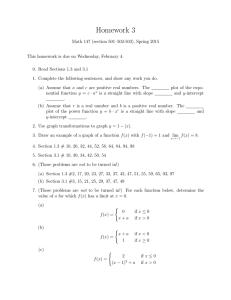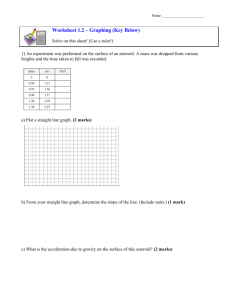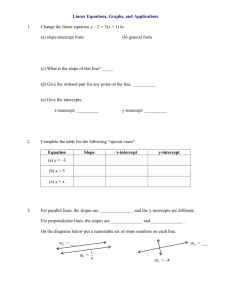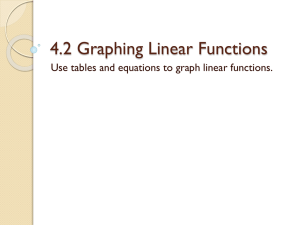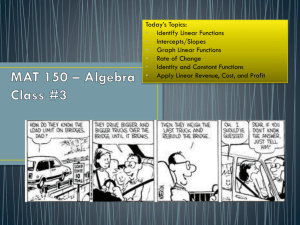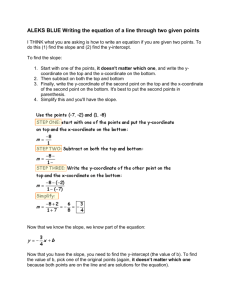GRAPHING WORKSHOP
advertisement
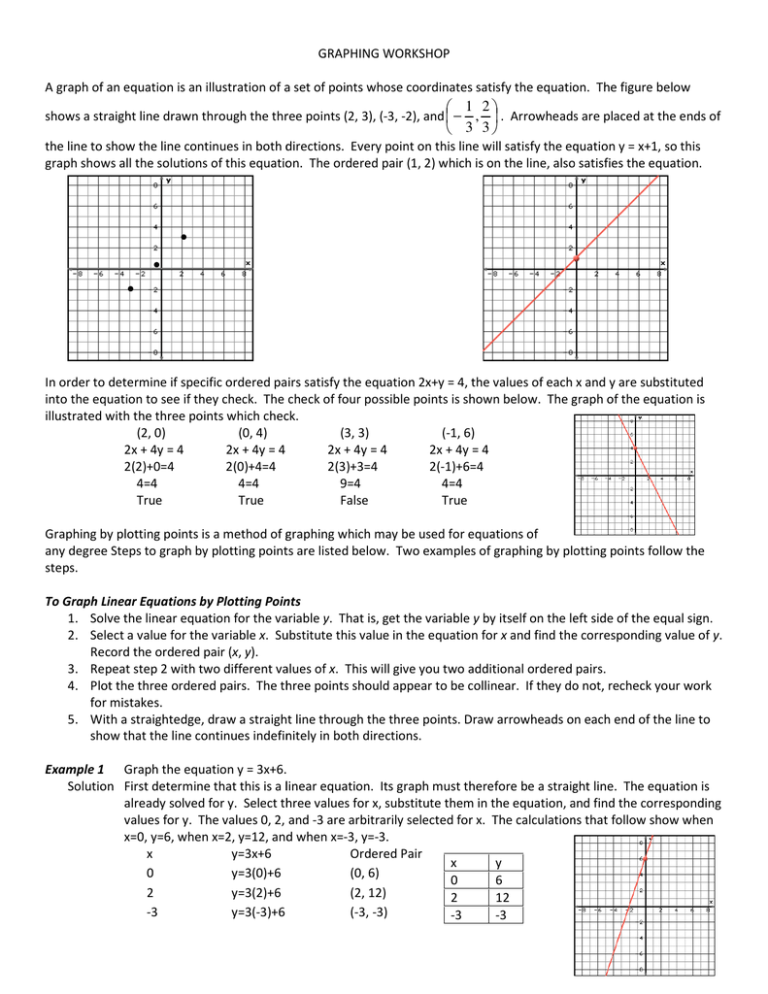
GRAPHING WORKSHOP A graph of an equation is an illustration of a set of points whose coordinates satisfy the equation. The figure below 1 2 3 3 shows a straight line drawn through the three points (2, 3), ((-3, -2), and − , . Arrowheads are placed at the ends of the line to show the line continues in both directions. Every point on this line will satisfy the equation y = x+1, x+1 so this graph shows all the solutions of this equation. The ordered pair (1, 2) which is on the line, also satisfies the equation. In order to determine if specific ordered pairs satisfy the equation 2x+y = 4, the values of each x and y are substituted into the equation to see if they check. The check of four possible points is shown below. The graph of the equation is illustrated with the three points which check. (2, 0) (0, 4) (3, 3) (-1, 6) 2x + 4y = 4 2x + 4y = 4 2x + 4y = 4 2x + 4y = 4 2(2)+0=4 2(0)+4=4 2(3)+3=4 2(-1)+6=4 4=4 4=4 9=4 4=4 True True False True Graphing by plotting points is a method of graphing which may be used for equations of any degree Steps to graph by plotting points are listed below. Two examples of graphing by plotting plott points follow the steps. To Graph Linear Equations by Plotting Points 1. Solve the linear equation for the variable y. That is, get the variable y by itself on the left side of the equal sign. 2. Select a value for the variable x.. Substitute this value in the equation for x and find the corresponding value of y. Record the ordered pair (x, y). 3. Repeat step 2 with two different values of x.. This will give you two additional ordered pairs. 4. Plot the three ordered pairs. The three points should appear to be collinear. If they do not, recheck your work for mistakes. 5. With a straightedge, draw a straight line through the three points. Draw arrowheads on each end of the line to show that the line continues indefinitely in both directions. Example 1 Graph the equation uation y = 3x+6. Solution First determine that this is a linear equation. Its graph must therefore be a straight line. The equation is already solved for y. Select three values for x, substitute them in the equation, and find the corresponding values for y. The values 0, 2, and -3 are arbitrarily selected for x. The calculations that follow show when x=0, y=6, when x=2, y=12, and when x= x=-3, y=-3. x y=3x+6 Ordered Pair x y 0 y=3(0)+6 (0, 6) 0 6 2 y=3(2)+6 (2, 12) 2 12 -3 y=3(-3)+6 (-3, -3) -3 -3 It is sometimes convenient to list the x and y values in a table. Then plot the three ordered pairs on the same axes. Since the three points appear to be collinear, the graph appears correct. Connect the three points with a straight line and place arrowheads at the ends of the line to show that the line continues infinitely in both directions. To graph the equation y=3x+6, the three values x=0, x=2, and x=-3 were arbitrarily chosen. Three entirely different values could have been chosen and obtained the exact same graph. When selecting values to substitute for x, use values that make the equation easy to evaluate. The graph drawn in Example 1 represents the set of all ordered pairs that satisfy the equation y=3x+6. If any point on this line is selected, the ordered pair represented by that point will be a solution to the equation y =3x+6. Similarly, any solution to the equation will be represented by a point on the line. Select some points on the line, such as, (1, 9) and (-2, 0), verify that they are solutions to the equation. Check: (1, 9) Check: (-2, 0) y=3x+6 y=3x+6 9=3(1)+6 0=3(-2)+6 9=3+6 0=-6+6 9=9 True 0=0 True Remember, a graph of an equation is an illustration of the set of points whose coordinates satisfy the equation. Example 2 Graph the equation 2y=4x-12 Solution Begin by solving the equation for y. This will make it easier to determine ordered pairs that satisfy the equation. To solve the equation for y, divide both sides of the equation by 2. Select three values for x and find the corresponding values for y using the equation y = 2x-6. y=2x-6 x y Let x=0 y=2(0)-6 0 -6 Let x=2 y=2(2)-6 2 -2 Let x=3 y=2(3)-6 3 0 Finally plot the points and draw the straight line. Graphing linear equations using x and y intercepts is also used. The x-intercept is the point at which a graph crosses the x-axis and the y-intercept is the point where the graph crosses the y-axis. If a graph crosses both the x and y axes at the origin, the x and y intercepts are both (0, 0). Finding intercepts is often a convenient method to use: two examples using intercepts are shown below. To Graph Linear Equations Using the x and y-Intercepts 1. Find the y-intercept by setting x in the given equation equal to 0 and finding the corresponding value of y. 2. Find the x-intercept by setting y in the given equation equal to 0 and finding the corresponding value of x. 3. Determine a check point by selecting a nonzero value for x and finding the corresponding value of y. 4. Plot the y-intercept (where the graph crosses the y-axis), the x-intercept (where the graph crosses the x-axis), and the check point. The three points should appear to be collinear. If not, recheck your work. 5. Using a straightedge, draw a straight line through the three points. Draw an arrowhead at both ends of the line to show that the line continues indefinitely in both directions. 6. Example 1 Graph the equation 3y=6x+12 by plotting the x and y-intercepts. Solution To find the y-intercept (where the graph crosses the y-axis), set x=0 and find the corresponding value of y. 3y=6x+12 3y=6(0)+12 3y=0+12 3y=12 y=12 y=4 The graph crosses the y-axis at 4. The ordered pair representing the y-intercept is (0, 4) To find the xintercept (where the graph crosses the x-axis, set y=0 and find the corresponding value of x. 3y=6x+12 3(0)=6x+12 0=6x+12 -12=6x -2=x The graph crosses the x-axis at -2. The ordered pair representing the x-intercept is (-2, 0). Now plot the intercepts. Before graphing the equation, select a nonzero value for x, find the corresponding value of y, and make sure that it is collinear with the x and y intercepts. This third point is the check point. Let x = 2 3y=6x+12 3y=6(2)+12 3y=12+12 3y=24 y =8 Plot the check point (2, 8). Since the three points appear to be collinear, draw the straight line through all three points. Example 2 Graph the equation 2x+3y=9 by finding the x and y intercepts. Solution Find y-intercept Find x-intercept Check Point Let x=0 Let y=0 Let x=2 2x+3y=9 2x+3y=9 2x+3y=9 2(0)+3y=9 2x+3(0)=9 2(2)+3y=9 0+3y=9 2x+0=9 4+3y=9 3y=9 2x=9 3y=5 y=3 x= y= The three ordered pairs are (0, 3), (, 0), and (2, ). The three points appear to be collinear Draw a straight line through all three points. The graph of an equation of the form y = b is a horizontal line whose y-intercept is (0, b). The graph of an equation of the form x = a is a vertical line whose x-intercept is (a, 0). Plotting points may also be used to graph equations of other types. Example 1 Graph the equation y=x2. Solution Since a=1, which is positive, this parabola opens upward. y=x2 x y Let x=3 y=(3)2 3 9 Let x=2 y=(2)2 2 4 Let x=1 y=(1)2 1 1 Let x=0 y=(0)2 0 0 2 -1 1 Let x=-1 y=(-1) -2 4 Let x=-2 y=(-2)2 -3 9 Let x=-3 y=(-3)2 Connect the points with a smooth curve. Note how the graph is symmetric about the line x=0 (or the yaxis). Example 2 Graph the equation 2 4 6 Solution Since a=-2, which is negative, this parabola opens downward. 2 4 6 x y Let x=5 y=-2(5)2+4(5)+6 5 -24 2 Let x=4 y=-2(4) +4(4)+6 4 -10 Let x=3 y=-2(3)2+4(3)+6 3 0 2 2 6 Let x=2 y=-2(2) +4(2)+6 2 1 8 Let x=1 y=-2(1) +4(1)+6 0 6 Let x=0 y=-2(0)2+4(0)+6 -1 0 Let x=-1 y=-2(-1)2+4(-1)+6 -2 -10 Let x=-2 y=-2(-2)2+4(-2)+6 -3 -24 Let x=-3 y=-2(-3)2+4(-3)+6 Example 3 Sketch the graph of | 2| Solution x -2 -1 3 | 2| 4 Solution (-2, 4) (-1, 3) 0 2 (0, 2) 1 1 (1, 1) 2 0 (2, 0) 3 1 (3, 1) 4 2 (4, 2) 5 3 (5, 3) The slope of a line is a ratio of the vertical change to the horizontal change between any two selected points on the line. As an example, consider the line that goes through the two points (3, 6) and (1, 2). To determine the slope of the line, find the vertical change (along the y-axis) 6-2, or 4 units and the horizontal change (along the x-axis) 3-1 or 2 units. slope = = ! ==2 By examining the line connecting these two points, the graph moves up 2 units on the y-axis as it moves to the right 1 unit on the x-axis. The procedure to find the slope of a line between any two points (x1, y1) and (x2, y2) is found by finding the vertical change over the horizontal change. " #" slope = = % #%$ $ It makes no difference which two points are selected when finding the slope of a line. It also makes no difference which point is labeled (x1, y1) or (x2, y2). Example 1 Find the slope of the line through the points (-6, -1) and (3, 5). Solution Designate (-6, -1) as (x1, y1) and (3, 5) as (x2, y2). & " #"$ % #%$ #'#() #'#*) +( * +* Thus the slope is . If we had designated (3, 5) as (x1, y1) and (-6, -1) as (x2, y2), the same result would have been obtained. & " #"$ % #%$ #(# #* # #*# A straight line for which the value of y increases as x increases has a positive slope. A line with a positive slope rises as it moves from left to right. A straight line for which the value of y decreases as x increases has a negative slope. A line with a negative slope falls as it moves from left to right. Negative slope – line falls from left to right Positive slope – line rises from left to right Slope-Intercept Form of a Linear Equation: & , where m is the slope, and (0, b) is the y-intercept of the line. slope & , Equations in slope-intercept form 3 6 ( 5 3 y-intercept Slope 3 ( -5 y-intercept (0, -6) .0, 1 (0, 3) .0, 1 To write a linear equation in slope-intercept form, solve the equation for y. To Graph Linear Equations Using the Slope and y-Intercept 1. Solve the linear equation for y. Put the equation in slope-intercept form, & ,. 2. Note the slope, m, and y-intercept, (0, b) 3. Plot the y-intercept on the y-axis. 4. Use the slope to find a second point on the graph. a. If the slope is positive, a second point can be found by moving up and to the right. Thus, when the slope is 3 in fraction form where p >0 and q >0, the second point is found by moving p units up and q units to the 4 right. b. If the slope is negative, a second point is found by moving down and to the right. Thus, when the slope is in 3 fraction form 4 the second point is found by moving p units down and q units to the right. 5. With a ruler, draw a straight line through the two points. Draw arrowheads at the ends of the line to show that the line continues indefinitely in both directions. Example 1 Write the equation -3x + 4y = 8 in slope-intercept form: then use the slope and y-intercept to graph -3x + 4y = 8. Solution 2 ! ! The slope of the line is and the y-intercept is (0, 2). Mark the first point, the y-intercept on the y-axis. Now use the slope ! to find a second point. Since the slope is positive, move 3 units up and4 units to the right to find the second point. A second point will be a (4, 5). Continue the process to obtain a third point at (8, 8). Now draw a straight line through the three points. Notice the line has a positive slope, which was expected. Example 2 Graph the equation 5x + 3y = 12 by using the slope and y-intercept. Solution Solve the equation for y. 5 3 12 3 5 12 # ( 4 Thus the slope is and the y-intercept is (0, 4). Begin by marking a point at 4 on the y-axis. Then move 5 units down and 3 units to the right to determine the next point. Move down and to the right because the slope is negative and a line with a negative slope must fall as it goes from left to right. Finally draw the straight line between the plotted points. Graphing Practice Problems In each problem, graph the solution and find the x and y intercepts. 1. 2 3 2. 1 3. 4 5 ( 4. 4 5. 3 6. 2 10. 5 4 4 11. 3 2 8 12. 5 2 8 ( ! 13. 3 14. 2 15. | 1| 7. 2 3 6 16. 4 8. 2 6 17. || 3 9. 3 4 12 18. ' 2) For each set of point, find the slope of the line which would connect them. 19. (1, -6), (-2, 5) 20. (0, 4), (-3, -6) 21. (1, -7), (4, 2) 22. (7, 2), (7, -4) 23. (-2, -6), (3, -2) 24. (-3, 4), (7, -4) 25. (3, -5), (0, -5) Answers 1. 2 3 2. 6. 2 1 7. 2 3 6 3. 4 5 8. 2 6 4. 4 9. 3 4 12 5. 3 10. 5 4 4 ( 11. 3 2 8 16. 4 12. 5 2 8 17. || 3 13. ! 3 18. ' 2) ( 19. 20. (7 (( 21. 3 22. Undefined 23. 14. 2 ! 25. 0 15. | 1| ! 24.
